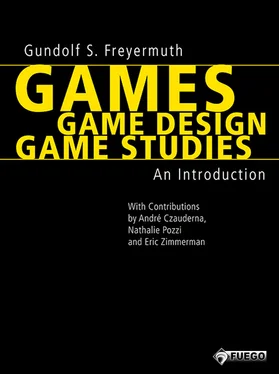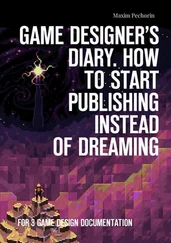Where is Game Studies today and in what direction is it developing?
In three chapters I will outline the stages of the media-historical development of analog and digital games ( I Games ), the history and artistic practices of their production in the context of analog and digital design ( II Game Design ), as well as the most important approaches and research questions of their analysis from the different perspectives of game design theory, social sciences and humanities ( III Game Studies ). Particular attention will be placed on the mutual relationship between game design and Game Studies in artistic-academic education and research.
First, two terms—which this volume already carries in its title—require clarification: games and game design . In Game Studies there has been some debate over which term best describes their object of scholarly focus— computer game, videogame, digital game . Computer game connotes games played on PCs and hardly those played on consoles, tablets or smartphones. Videogame connotes games that use moving pictures, meaning also pre-digital games like TENNIS FOR TWO (1958) or analog arcade games of the 1960s and 1970s. Corresponding thoughts can be found, for example, by Jesper Juul and Tristan Donovan. 1Both authors have, for different reasons, nonetheless decided on the term videogame . However, in order to place the emphasis on games with a basis in digital technology, in this book I will primarily speak of digital games and will use games as a synonym to refer to the same concept. Older forms of games I will specifically reference as analog games . 2
The term ‘game design’ is no less undefined. An important reason for this is the lack of codification with regard to the different roles involved in the production of digital games. So far a clear division of labor, as witnessed in theater, film and television, does not exist in game production. Game design is, therefore, often used to mean two different things: either to designate the entire process of game development or to designate a specific field of work in this production process along with the likes of game arts or game informatics. 3
The title of this introduction uses the term clearly in the first, synecdochic sense: This book concerns itself with digital games, their production and their analysis. A central aspect of this process of production is, of course, game design in the second, narrower sense, which will be a central topic in chapter II Game Design .
PLAYING—GAMES
In his “Manifesto for a Ludic Century” 4the game designer and game design theoretician Eric Zimmerman presents the thesis that a structural affinity exists between the fundamental characteristics of digital technology and the fundamental characteristics of games, analog as well as digital: “Games like Chess, Go, and Parcheesi are much like digital computers, machines for creating and storing numerical states. In this sense, computers didn’t create games; games created computers.” 5Beyond that, digital networking would promote evermore-complex information systems. For a digital culture shaped by such systems, games would be the ideal medium thanks to their systematicity: “[G]ames are dynamic systems […] While every poem or every song is certainly a system, games are dynamic systems in a much more literal sense. From Poker to Pac-Man to Warcraft, games are machines of inputs and outputs that are inhabited, manipulated, and explored.” 6
Film and television, the defining media of the 20th century, corresponded—with the linearity of their passively received audivisions—to the information and entertainment needs of industrial work and culture. Digitalization, however, writes Zimmerman, initiated a categorical metamorphosis: “In the last few decades, information has taken a playful turn. […] When information is put at play, game-like experiences replace linear media.” 7Games would, therefore, become the most important medium of the ludic 21st century: “Increasingly, the ways that people spend their leisure time and consume art, design, and entertainment will be games—or experiences very much like games.” 8
Zimmerman’s “ludic manifesto” can be understood as a concise depiction of perspectives and opinions that are circulating in contemporary culture. Indeed, before our eyes a lasting medial upheaval is taking place that targets audiovisual forms of expression and representation. Their transformation is the product of technological progress—a development which has already occurred twice in modern times. 9
Between the Renaissance and the Enlightenment, mechanization brought about the theater of illusion with its proscenium or picture-frame stage, outfitted with the most modern technical means available. For example, equipment and procedures used in shipbuilding to quickly move heavy objects were put into practice in theaters to move sets and even actors. Thanks to its mechanical means for manipulating space and time, the theater of illusion and its most important genre, the drama, became the genuine audiovisual form of storytelling in the pre-industrial period.
With the next technological push brought about between the Enlightenment and postmodern times through industrialization, photography was introduced, followed by film and, finally, television; the last two, of course, were based on the technology first developed for and by photography. Through means of stored, edited and “made to move” pictures and sounds, time and space could be manipulated as never before and new kinds of stories could be told audiovisually. This categorical performance increase over the theater—the potential for a successive development of epicness of audiovisual representation—film and television owe to evermore-advanced industrial recording, storing, editing, distribution and transfer techniques. In the medium of linear audiovisuality, feature films and television series emerged as genuine and dominant storytelling methods of industrial culture. Thus, since the early 20th century, first silent movies, then talkies, and finally television influenced the audiovisual construction of reality and its perception.
Against this media-historical background it should be no surprise that aesthetic consequences are also tied to the current technological push: digitalization. Digital software allows the recording, generation, storing, editing, distribution and interactive manipulation of texts and sounds, as well as still and moving pictures. Through two unique characteristics, software thereby distinguishes itself from all analog media as a means of production and storage. First, software is transmedial. In the universal medium of stored bits and the software programs with which they can be edited, the analog diversity of specific media and tools—paper and typewriter, celluloid, camera and cutting room, vinyl, magnetic tape, microphone and mixing board etc.—is unified. Second, the digital transmedium possesses a ‘fluidity’ that, together with feedback systems, to a large extent eliminates the primacy of chronology that characterizes analog mediality. 10In this quality lies the principal interactivity of the transmedium known as software.
This potential for transmediality and fluidity is aesthetically realized above all in digital games. Earlier, movies simultaneously expressed the experiences of, and impacted, industrial culture—not least in the industrial work environments of hierarchical and linear processes. The experiences of digital culture are expressed similarly today in digital games, which are now also impacting the postindustrial work environment that is characterized by knowledge-work, i.e., networked manipulation of digital symbols. The machine as central metaphor for industrial culture is replaced by the game as a central metaphor for digital culture. 11
Читать дальше











